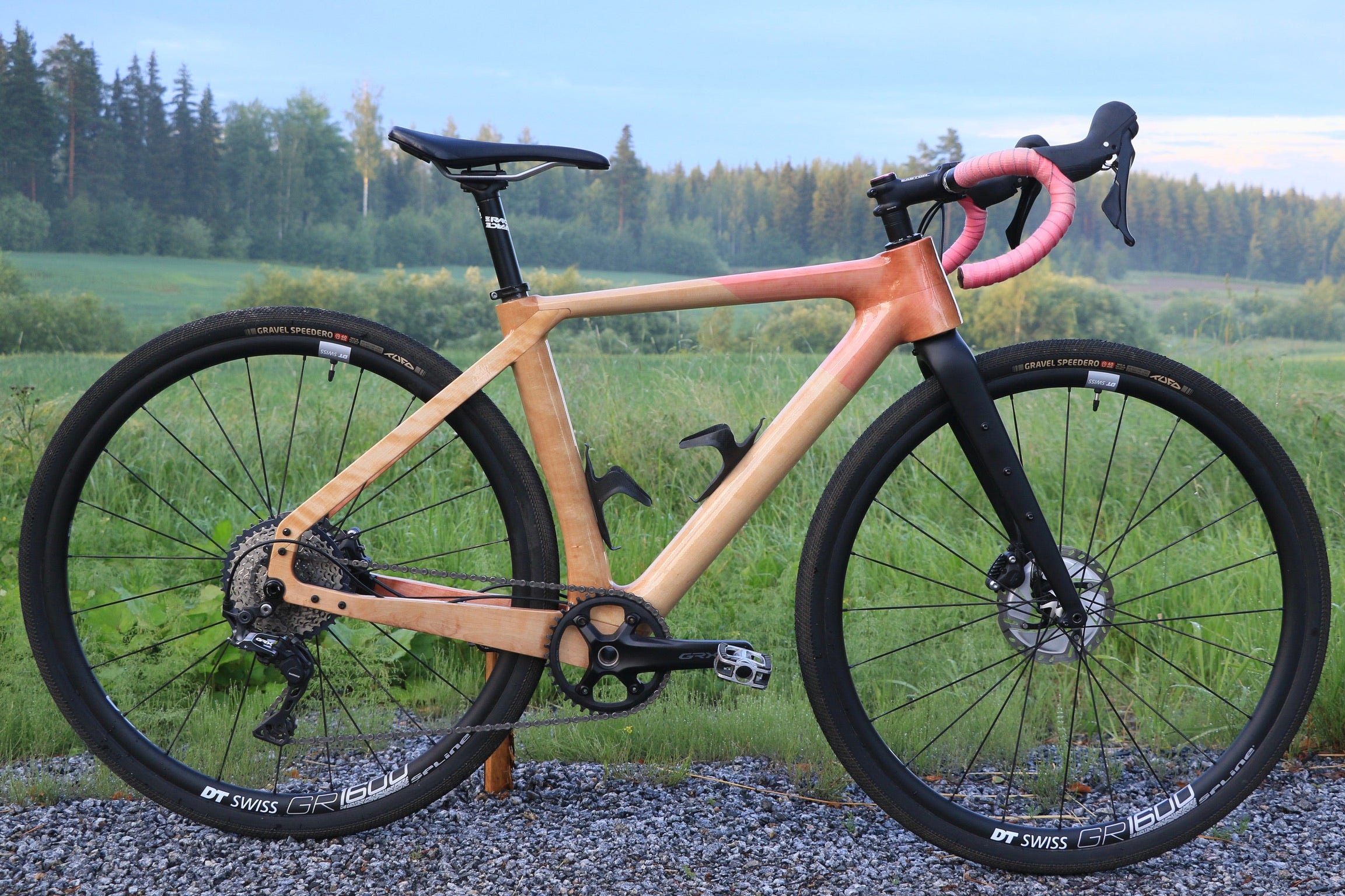It's time to continue our recently introduced format, "Greppers of Gaia" where we interview people around us. Some might be old friends, new friends, or total strangers we know from the digital world.
This time it's a friend of Jan. Someone you might have seen on our posts already.
Meet Allan Foreman.

Intro
Allan is an Australian based in Finland, builds wooden bikes, and rides them to the fullest. He was one of our Test riders during the development of the Gripper. It's worth mentioning that Allan was also a Test rider actually not nominated in the first place by us. Instead, he got our tape from the local bike shop Breakaway.cc . This was great but scary for us as we had no control over the process and knew nothing about his riding skills and knowledge around bikes. However, it turned out we received a custom frame building test rider with valuable feedback for our product development as well gained a great friend who is always up for a spin.
J- Could you introduce yourself to our readers?
A- My name is Allan Foreman. Born and raised in Brisbane, Australia. For 3 years, I call Finland my home.
J- Do you have a Nickname?
A- In high school, my nickname was Alfie, but now it's just Al or Allan.
J- What's your profession?
A- I am an Engineering Patternmaker by trade Back in Australia. I made the timber originals (masters) of steel castings to very precise tolerances. We made iron castings ranging in size from 20mm to about 4m long. This was all done by hand and with manual machines.
Since moving to Finland, I have been building sauna/dressing room benches and Timber bikes in my spare time.
J- When I want a bike instead of a sauna bench from you, which name should I lookup?
A- You should look for Foreman Bikes (@foreman.bikes or foremanbikes.com) to find my contact details.

J- Explain to us what is your vision for Foreman bikes?
A- I want to be able to have a connection to my customers and follow an organic growth plan to ensure this connection isn't lost over time.
J- What was the trigger for you to start making bikes by yourself and from wood?
A- It all started when I wanted to upgrade my then-current bike. So I started my search and then came across a photo of a timber bike. This opened a rabbit hole that I couldn't resist going down! Everyone I told that I would make my next bike out of timber thought I was crazy, which made me even more determined to make my first timber frame.
I had a shoulder reconstruction in 2015 and had to have 7 months off work. This gave me plenty of time to get a pretty solid plan to start working on.
J- Why wood for building bikes?
A- Wood is natures carbon fibre. With careful selection of the type of timber and inspecting how the grain has grown, it is very strong and has excellent shock dampening properties.
J- Where do you get your information about the how-to from?
A- My initial frame was built almost solely from photos I found and knowledge of the strengths and weaknesses of timber. For some reason, the people making successful frames are really secretive about their process. This led to most of the information I found was more of a what-not-to-do.
As a Patternmaker, I already had a lot of experience in reverse engineering old castings. I felt this was the exact same process of looking at photos of wooden bikes and figuring out how the frames were constructed. After many photos, I had a pretty solid plan! Since that first frame, my processes have constantly been developing. I have a strong 'continuous improvement' mindset.
J- Can you explain how the typical process of making a bike looks like?
A- Before any sawdust is made, the customer's measurements are taken, and we have an open discussion about what they want from their future bike. The frame geometry is calculated, and then a layout is drawn 1:1 scale.
From this layout, templates are then made for each individual piece of timber. Every layer of timber is a different shape, so all the joints overlap, minimizing any stress points.
The most crucial part is then selecting the perfect piece of timber. The grain has to run straight and be reasonably close together.
Once all the pieces are cut to size using the templates and are planned to the correct thickness, the puzzle pieces are glued together to produce two separate halves of the frame.
The head tube, seat tube, and Bottom Bracket inserts are made, then fitted (but not glued, so the halves are still separate)
The outside profile is then shaped by hand, and the chain stays, and the seat stays are fitted.
Once the outside is at its final shape, the inside can be hollowed out to the desired thickness.
The internal cable sleeves are fitted, inserts are put in place, the inside profile is sealed, and the frame is bonded together.
The frame is then ready for the final sand, and topcoats are applied.
J- What are the most challenging areas when making a bike from wood?
A- Like all bikes, the area around the bottom bracket, chainring, seat tube, and tire. Some of the bends are so tight I need to steam bend the chainstay laminations before gluing them into the profile molds.
J- Why do you think there are so few wooden bikes around?
A- I think the biggest problem is people believe the material isn't strong enough. There needs to be more education to convince cyclists how strong high quality timber really is. Many household timber products (like a broomstick) are made cheaply from low-quality timber, a vast difference from a high-quality handmade bike. I have done a few in-house tests of my laminations and have now ridden over 8000 hard kilometres in extreme weather (from -25 degrees to +30 degrees) without any problems. I would love to do some ISO testing to show people in the future, so I have some numbers.

J- How do wooden bikes compare to carbon and metal bikes with regards to sustainability?
A- I believe the most significant sustainability advantage of a wooden bike compared to steel or carbon bikes is simply the energy it takes to produce the raw materials. This can then further be increased with the use of hand tools to shape the frame and bio-based epoxies for bonding and sealing.
J- After just being stoked about the story around the frame building and how Allan ended up doing it, we wanted to know some basic bike scene details.
How did you end up riding bikes?
A- As far back as my memories go, I've been riding anything with two wheels. But I got into road cycling when I was 18. I was always running and swimming for fitness and decided that we should start training for triathlons with a friend. So I bought a bike, did 2 triathlons, and finally decided I didn't need to run anymore and just kept cycling.
J- What motivates you to ride a bike?
A- It's my happy place! While I'm on the bike, nothing else matters. It is all about me and the bike. If I've had a bad day, a ride can fix it! I also love the mental/physical aspect of pushing your body to the limit (this is the racer mindset in me).
J- Describe how the optimal bike looks like and what it stands for in your very own words.
A- A bike is freedom. From the first pedal strokes, I don't want it to end. Since moving to Finland, it has really helped me get to know the surrounding regions and meet some great people!
The optimal bike doesn't really look a specific way. It's more of a feeling. When you look at your bike, it makes you want to ride it. When you ride it, you need to smile and not want to stop. That is the perfect bike!
J- When you ride your bike, do you get the smile and don't want to stop?
A- I do get that when I ride my Foreman Bikes custom Gravel

Foreman Bikes custom Gravel
Frameset- Foreman Bikes custom Gravel
Groupset- Shimano GRX600 1x11
Wheelset- Dt-Swiss G1800
Handlebars- Ritchey Comp Ergo Max 480mm
Stem- Ritchey Comp 4axis
Seat post- Ritchey Comp zero offset
Seat- Pro Falcon
Bar tape- Grepp Gripper
Pedals- Shimano M520 SPD
Tyres- Tufo Thundero 700x40
J- Would you call your riding race- or partypace?
A- I would love to say party pace, but I grew up racing dirt bikes. So I'm a racer through and through!
J- Are you listening to music while riding?
A- Not while riding. Nature is my soundtrack. I also like to know when cars are coming from behind…
J- What would you want to change about the cycling scene?
A- This is tough because I have found a great cycling community here in Helsinki. But I think there is room for improvement with beginner cyclists, the people who think 20km is a long way. They are already intimidated by other cyclists who have all the kit, then they find out the group ride is 50km+. It's hard to get a nice ride that's only 20km long when you live in the city, but I think there could be many more 'hobby cyclists' if this category was catered for. This could even be as simple as the bike shops offering some form of education on how to prepare for a longer ride and how to properly repair the common 'breakdowns' so everyone can get home safely and confidently. I also believe that it's essential for these cyclists that the group rides remain fun and relaxed. The fastest way to discourage a beginner is if they are constantly being dropped!
Another problem worldwide is the rage that other road users have towards cyclists. If everyone could just have a bit of patience, the roads would be a lot better to ride.
J- What do you think about Grepp handlebar tapes?
A- I think they are great! I've recently started commuting without my cycling gloves and have fallen in love even more. They are hard but soft (I can't describe the feeling). You can feel the feedback from the road, but they are gentle on your hands. The fact you can just keep using them is excellent, especially if you are playing around with different bar setups!
J- Anything else you like to share?
A- Ride your bike so you can enjoy the pizza and beers after!

And for all out there interested in a wooden custom bike. You know where to find a maker for it.









